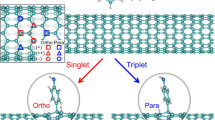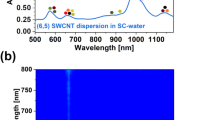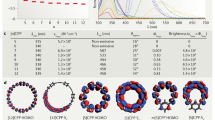Abstract
Single-wall carbon nanotubes (SWNTs) are emerging as materials with much potential in several disciplines, in particular in electronics and photovoltaics. The combination of SWNTs with electron donors or acceptors generates active materials, which can produce electrical energy when irradiated. However, SWNTs are very elusive species when characterization of their metastable states is required. This problem mainly arises because of the polydispersive nature of SWNT samples and the inevitable presence of SWNTs in bundles of different sizes. Here, we report the complete and thorough characterization of an SWNT radical ion-pair state induced by complexation with a perylene dye, which combines excellent electron-accepting and -conducting features with a five-fused ring π-system. At the same time, the perylene dye enables the dispersion of SWNTs by means of π–π interactions, which gives individual SWNTs in solution. This work clears a path towards electronic and optoelectronic devices in which regulated electrical transport properties are important.
This is a preview of subscription content, access via your institution
Access options
Subscribe to this journal
Receive 12 print issues and online access
$259.00 per year
only $21.58 per issue
Buy this article
- Purchase on Springer Link
- Instant access to full article PDF
Prices may be subject to local taxes which are calculated during checkout






Similar content being viewed by others
References
Lu, W. & Lieber, C. M. Nanoelectronics from the bottom up. Nature Mater. 6, 841–850 (2007).
Kauffman, D. R. & Star, A. Electronically monitoring biological interactions with carbon nanotube field-effect transistors. Chem. Soc. Rev. 37, 1197–1206 (2008).
Prato, M., Kostarelos, K. & Bianco, A. Functionalized carbon nanotubes in drug design and discovery. Acc. Chem. Res. 41, 60–68 (2008).
Viry, L., Derré, A., Garrigue, P., Sojic, N., Poulin, P. & Kuhn, A. Optimized carbon nanotube fiber microelectrodes as potential analytical tools. Anal. Bioanal. Chem. 389, 499–505 (2007).
Campidelli, S., Meneghetti, M. & Prato, M. Separation of metallic and semiconducting single-walled carbon nanotubes via covalent functionalization, Small 3, 1672–1676 (2007).
Kong, J. et al. Nanotube molecular wires as chemical sensors. Science 287, 622–625 (2000).
Collins, P. G., Bradley, K., Ishigami, M. & Zettl, A. Extreme oxygen sensitivity of electronic properties of carbon nanotubes. Science 287, 1801–1804 (2000).
Star, A., Joshi, V., Skarupo, S., Thomas, D. & Gabriel, J.-C. P. Gas sensor array on metal-decorated carbon nanotubes. J. Phys. Chem. B 110, 21014–21020 (2006).
Kazaoui, S., Minami, N. & Jacquemin, R. Amphoteric doping of single-wall carbon-nanotube thin films as probed by optical absorption spectroscopy. Phys. Rev. B 60, 13339–13342 (1999).
Carrol, D. L. et al. Effects of nanodomain formation on the electronic structure of doped carbon nanotubes. Phys. Rev. Lett. 81, 2332–2335 (1998).
Zhao, Y.-Z., Hu, L., Grüner, G. & Stoddart, J. F. A tunable photosensor. J. Am. Chem. Soc. 130, 16996–17003 (2008).
Guldi, D. M., Rahman, G. M. A., Sgobba, V. & Ehli, C. Multifunctional molecular carbon materials – from fullerenes to carbon nanotubes. Chem. Soc. Rev. 35, 471–487 (2006).
Tasis, D., Tagmatarchis, N., Bianco, A. & Prato, M. Chemistry of carbon nanotubes. Chem. Rev. 106, 1105–1136 (2006).
Paolucci, D. et al. Singling out the electrochemistry of individual single-walled carbon nanotubes in solution. J. Am. Chem. Soc. 130, 7393–7399 (2008).
Herranz, M. Á. et al. Spectroscopic characterization of photolytically generated radical ion pairs in single-wall carbon nanotubes bearing surface-immobilized tetrathiafulvalenes. J. Am. Chem. Soc. 130, 66–73 (2008).
Schmidt, C. D., Böttcher, C. & Hirsch A. Synthesis and aggregation properties of water-soluble Newkome-dendronized perylenetetracarboxdiimides. Eur. J. Org. Chem. 5497–5505 (2007).
Bachilo, S. M. et al. Structure-assigned optical spectra of single-walled carbon nanotubes. Science 298, 2361–2366 (2002).
Tomonari, Y., Murakami H. & Nakashima, N. Solubilization of single-walled carbon nanotubes by using polycyclic aromatic ammonium amphiphiles in water—strategy for the design of high-performance solubilizers. Chem. Eur. J. 12, 4027–4034 (2006).
Margineanu, A. et al. Photophysics of a water-soluble rylene dye: comparison with other fluorescent molecules for biological applications. J. Phys. Chem. B 108, 12242–12251 (2004).
Hayes, R. T., Wasielewski, M. R. & Gosztola, D. Ultrafast photoswitched charge transmission through the bridge molecule in a donor–bridge–acceptor system. J. Am. Chem. Soc. 122, 5563–5567 (2000).
Kaletas, B. K. et al. Photoinduced electron and energy transfer processes in a bichromophoric pyrene–perylene bisimide system. J. Phys. Chem. A 108, 1900–1909 (2004).
Guldi, D. M., Hungerbuehler, H. & Asmus, K. D. Radiolytic reduction of a water-soluble fullerene cluster. J. Phys. Chem. A 101, 1783–1786 (1997).
Acknowledgements
This work was carried out with financial support from the Deutsche Forschungsgemeinschaft, Cluster of Excellence ‘Engineering of Advanced Materials’, Fonds der Chemischen Industrie, the Office of Basic Energy Sciences of the US, University of Trieste, Giovani Ricercatori Program, Consorzio Interuniversitario Nazionale per la Scienza e Tecnologia dei Materiali, Ministero dell'Istruzione, dell'Università e della Ricerca, and Freiburg Institute for Advanced Studies (Junior Research Fellowship). We thank C. Gamboz and J. Röhrl for their assistance with TEM imaging and Raman microscopy, respectively.
Author information
Authors and Affiliations
Contributions
C.E. performed and interpreted all steady-state and time-resolved absorption and emission measurements and the electrochemical experiments. D.M.G. interpreted the data, supervised the research and wrote the manuscript. C.O. performed and interpreted the Raman microscope and in situ Raman measurements. A.M.A. performed and interpreted AFM and TEM data. M.P. helped to analyse the data and write the manuscript. C.S. synthesized the detergents. C.B. provided expertise on the dispersion of SWNTs. F.H. supervised the chemistry and SWNT dispersion. A.H. supervised the synthesis of the detergents.
Corresponding author
Supplementary information
Supplementary information
Supplementary information (PDF 843 kb)
Rights and permissions
About this article
Cite this article
Ehli, C., Oelsner, C., Guldi, D. et al. Manipulating single-wall carbon nanotubes by chemical doping and charge transfer with perylene dyes. Nature Chem 1, 243–249 (2009). https://doi.org/10.1038/nchem.214
Received:
Accepted:
Published:
Issue Date:
DOI: https://doi.org/10.1038/nchem.214
This article is cited by
-
Perylene derivatives for solar cells and energy harvesting: a review of materials, challenges and advances
Journal of Materials Science: Materials in Electronics (2019)
-
Interest of molecular functionalization for electrochemical storage
Nano Research (2017)
-
On the Stability and Abundance of Single Walled Carbon Nanotubes
Scientific Reports (2015)
-
Electronic and transport properties of boron and nitrogen doped graphene nanoribbons: an ab initio approach
Applied Nanoscience (2014)
-
A supramolecular approach to fabricate highly emissive smart materials
Scientific Reports (2013)



